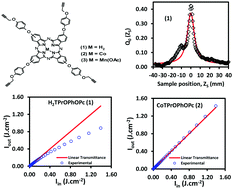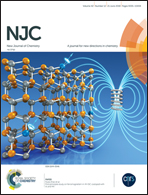The effect of the cobalt and manganese central metal ions on the nonlinear optical properties of tetra(4-propargyloxyphenoxy)phthalocyanines†
Abstract
The metal-free (H2TPrOPhOPc), cobalt (CoTPrOPhOPc) and manganese (Mn(OAc)TPrOPhOPc) tetra propargyloxyphenoxy phthalocyanines were evaluated for their potential as optical limiting materials. The effect of the substituents and the central metal ions on the nonlinear optical properties was evaluated. The metal-free phthalocyanine exhibited better nonlinear optical properties when compared to the cobalt and manganese complexes owing to the metal ions quenching the excited state due to their half-filled d-orbitals. The nonlinear absorption coefficient (βeff, ×10−5 m MW−1) followed the trend of H2TPrOPhOPc > CoTPrOPhOPc > Mn(OAc)TPrOPhOPc. The values βeff (×10−5 m MW−1) using 532 nm Nd:YAG (560 nm monochromatic Ekspla) laser sources were 23.5 > 14.3 > 9.20 (14.4). The second-order nonlinear coefficient obtained using density functional theory calculations, the theoretical hyper-Rayleigh scattering (βHRS, ×10−28 esu), showed the decreasing trend for H2TPrOPhOPc (2.28) > CoTPrOPhOPc (2.10) > Mn(OAc)TPrOPhOPc (1.86). The 4-(propargyloxy)phenoxy substituents enhanced the optical limiting properties of the synthesized phthalocyanines.



 Please wait while we load your content...
Please wait while we load your content...